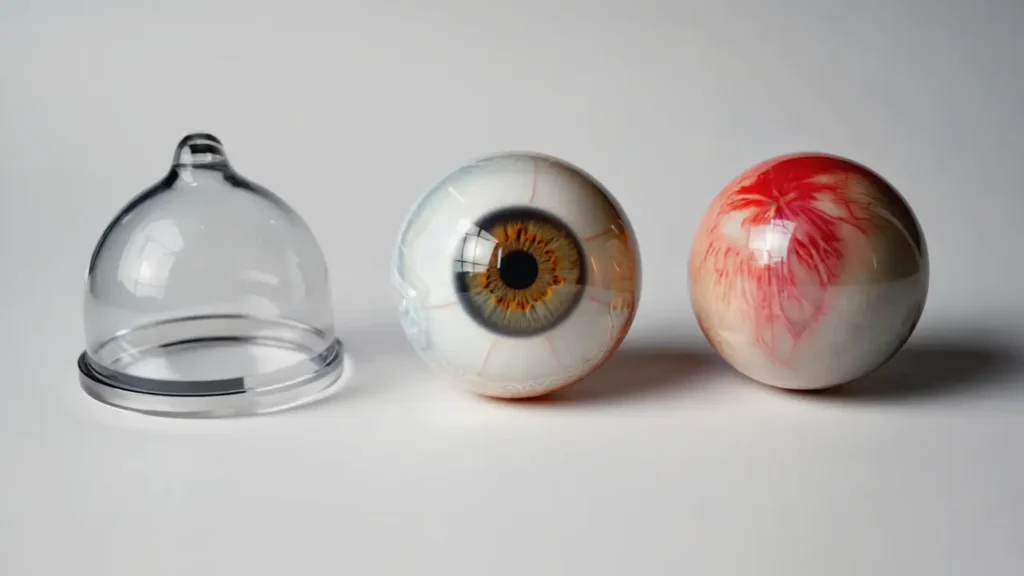A corneal transplant can save sight, but it’s not always the final solution. Many patients continue to face challenges after surgery: optical distortions, dryness, discomfort or changes in the eye’s appearance. This is where specialised lenses come in – each designed to address a different need.
EyePrintPRO – Microscopic precision
- Scleral lenses based on a unique “eye impression” that create a completely custom lens.
- Designed primarily for functional rehabilitation – delivering crisp, stable vision even in complex eyes after transplantation.
- Advantages: create an entirely new optical surface, protect the cornea with a constant fluid layer and provide an effective solution for conditions like advanced keratoconus or failed transplants.
Prosthetic lenses – Aesthetic and rehabilitative solution
- These lenses aim first and foremost to restore a natural look when the eye differs in colour or structure (scars, amblyopia, differences between two eyes).
- They sometimes incorporate mild optical elements, but their main role is cosmetic.
- Advantages: improve self‑image and confidence, are especially suitable when vision is good but appearance is compromised, and can be hand‑painted to match the healthy eye.
Why are special lenses needed after a corneal transplant?
A corneal transplant is a sight‑saving operation, yet many patients still struggle with distortions, scars, severe dryness or changes in appearance. In some cases it’s about improving visual acuity, in others about aesthetics – restoring a natural look. On our clinic’s website there is a dedicated page outlining the available solutions. The combination of up‑to‑date technology and personalised fitting allows patients to regain high‑quality vision even in complex situations.
EyePrintPRO – Rehabilitation at microscopic level
EyePrintPRO lenses are based on a personal “eye print” taken with a special impression. This unique 3D imaging makes it possible to create a lens that exactly mirrors the eye’s surface – a perfect solution after a corneal transplant, especially when there are extreme irregularities or significant asymmetry.
Advantages of EyePrintPRO:
- A completely new optical surface
- Suitable for advanced keratoconus or deep scars
- Fits even the most challenging eye shapes (including pinguecula)
- Works for extreme dryness or failed transplants (where the patient cannot tolerate any other lens)
Prosthetic lenses – Aesthetics and confidence
Custom prosthetic lenses are primarily designed to restore a natural look to an injured eye – whether due to a corneal scar, strabismus or different coloured eyes. They are usually hand‑painted in advanced laboratories to blend seamlessly with the healthy eye. Beyond aesthetics, in some cases they also incorporate minor optical corrections (e.g. cylinder correction) but the main focus is restoring confidence and comfort in social situations.
Scleral lenses – A foundation for complex solutions
In many cases, particularly after a corneal transplant, scleral lenses act like a miracle. These lenses “hover” over the cornea, creating a protective fluid layer that not only improves vision but also helps the eye heal. Scleral lenses can be made with EyePrintPRO technology and can sometimes be combined with a soft prosthetic lens to create a complete solution. There are situations where we need to correct distortions with a scleral lens like EyePrintPRO and then add a cosmetic lens on top for appearance.
HOA correction – Sharper vision
When advanced higher‑order aberrations remain, some scleral lenses (not all manufacturers offer this) can incorporate HOA correction – a technology that enables even sharper vision, particularly at night or in poor lighting conditions.
Dry eye – A common challenge after transplantation
Roughly 40% of patients after a corneal transplant suffer from chronic dry eye symptoms. Although scleral lenses themselves are a treatment for dryness, in severe cases it’s crucial to combine dry‑eye therapy alongside lens fitting. Untreated dryness can reduce visual quality (especially when tear film becomes overly oily) and make lenses uncomfortable.
Statistics: Why this is so important
- International studies show that 30–40% of corneal transplant patients continue to suffer significant optical problems.
- Over 50% report a marked improvement in vision after fitting advanced scleral lenses.
- EyePrintPRO yields satisfaction rates above 85% among patients with complex eye shapes.
FAQ
- Are special lenses always needed after a corneal transplant? Not necessarily. For some, glasses are enough, at least initially, because the tissues may adapt over time. When distortions or severe dryness occur, however, special lenses become life‑changing.
- What’s the difference between EyePrintPRO and a regular scleral lens? EyePrintPRO is based on a unique eye impression and is customised on a microscopic level, while a standard scleral lens is based on personalised measurements but follows a more standardised design.
- Who are prosthetic lenses suitable for? Mainly for patients with aesthetic concerns – scars from chemical burns, differently coloured eyes, strabismus and the like – who want a natural look.
- How long do prosthetic or EyePrintPRO lenses last? Prosthetic lenses are soft, so they’re typically replaced after about a year as they absorb bacteria over time. Scleral and EyePrintPRO lenses are made from a rigid material that does not absorb bacteria, so they have no defined expiry date. Their life depends on how well the lens continues to fit the eye, the materials used and the patient’s hygiene routine.
- Do health funds cover the cost? In clear medical cases (like corneal transplant or chronic eye disease) there may be partial reimbursement through HMOs or supplementary insurance.
Summary
Special lenses after a corneal transplant aren’t just an option – for many they are the key to restoring both sight and appearance. Whether it’s EyePrintPRO for extreme irregularities, a prosthetic lens for a natural look, or advanced scleral lenses for overall protection, M’Eye Clinic combines up‑to‑date technology, clinical expertise and compassionate care to offer each patient a personalised, effective solution.

